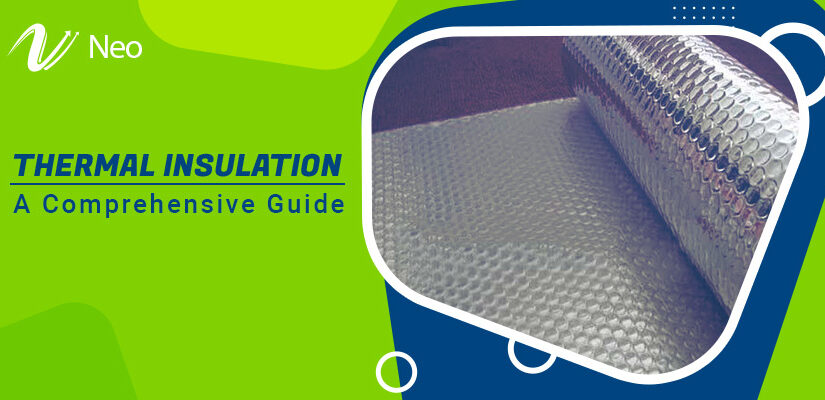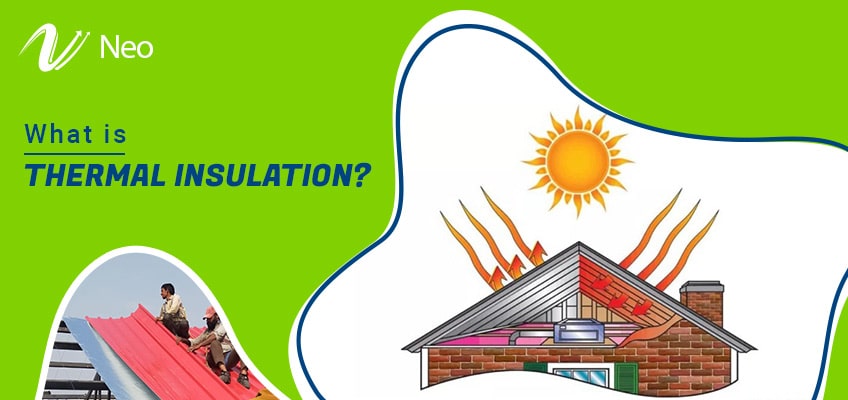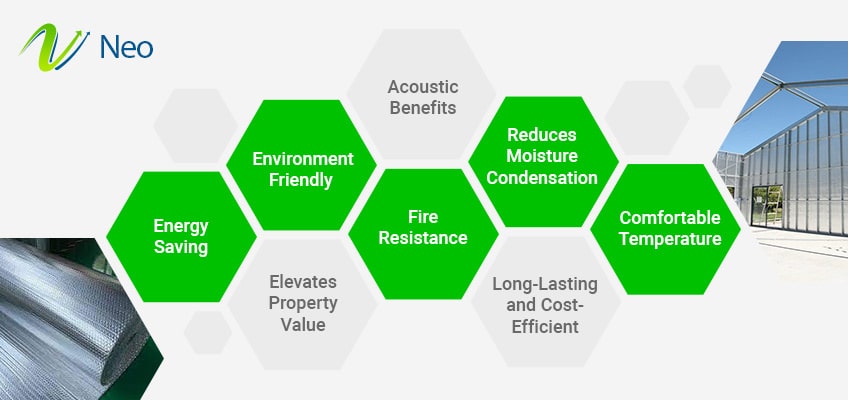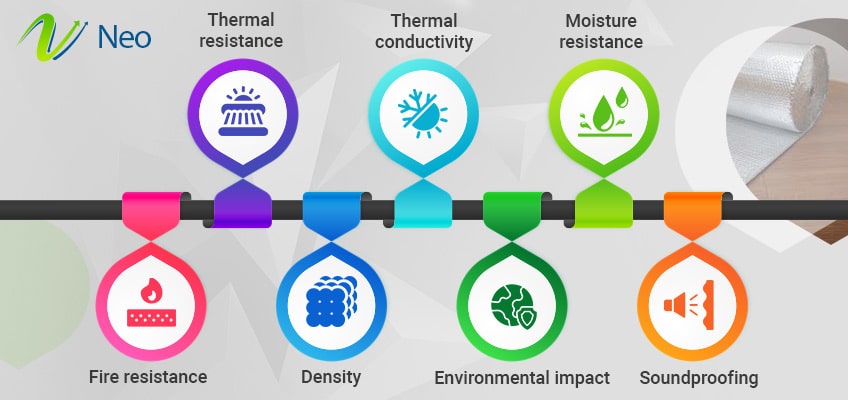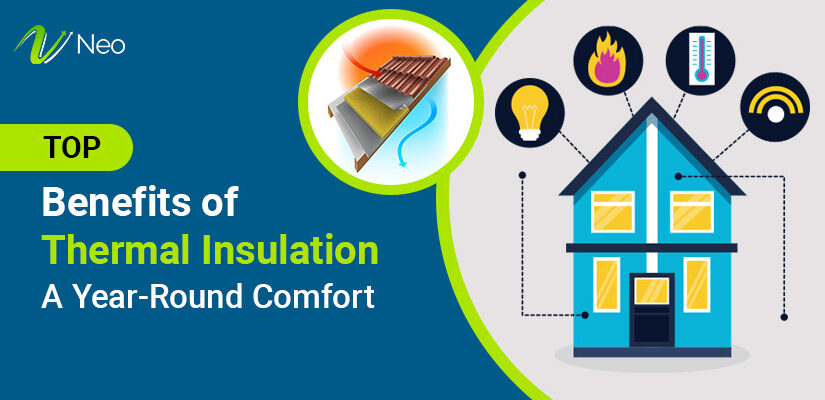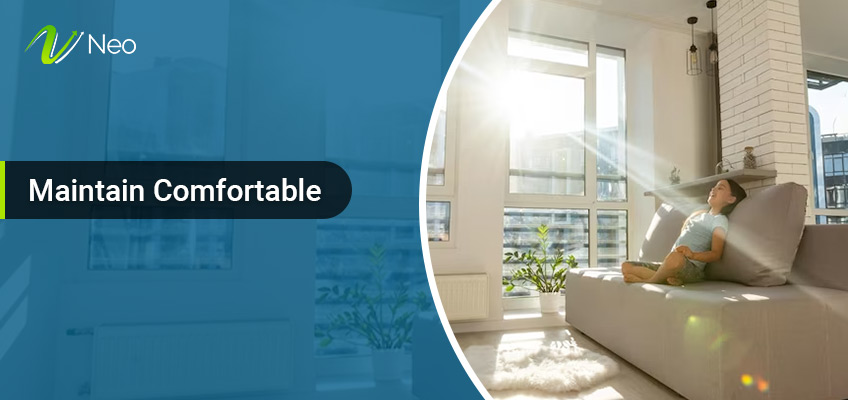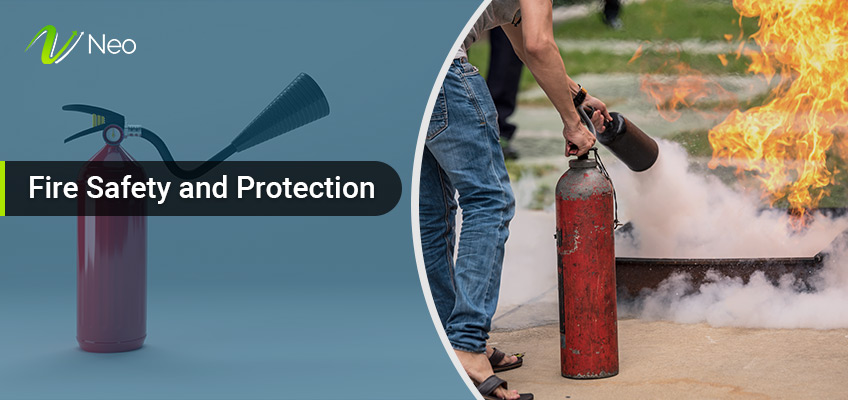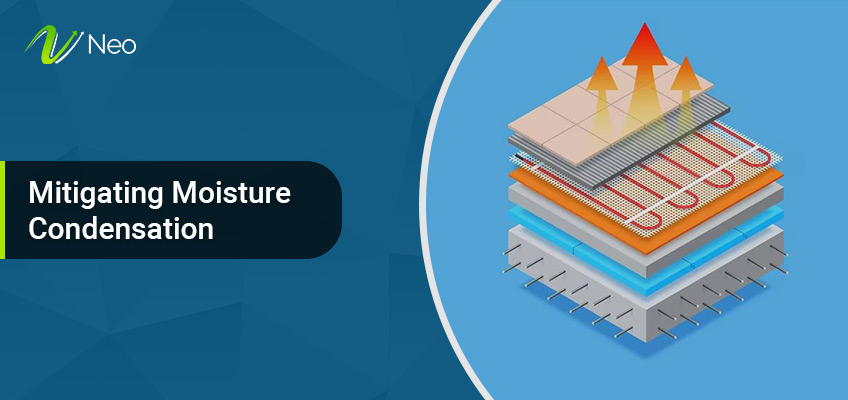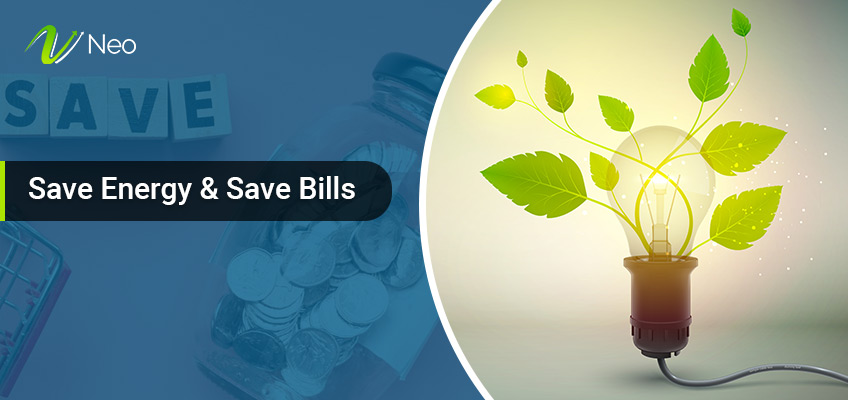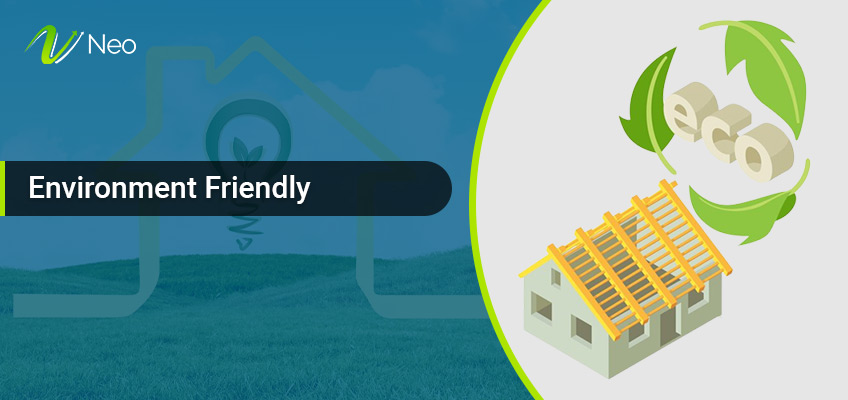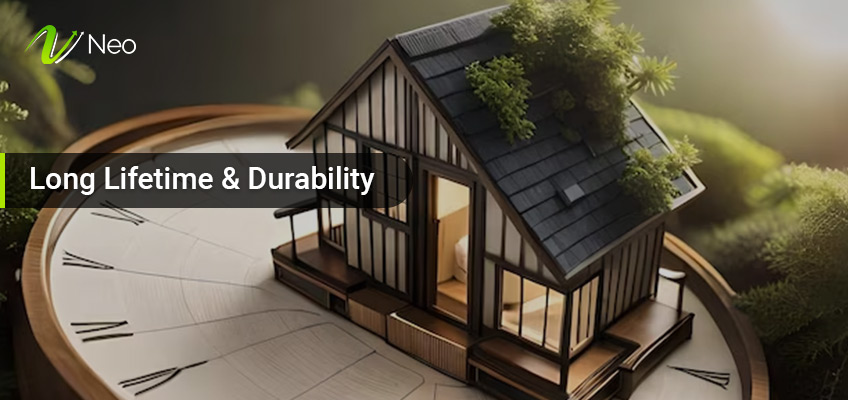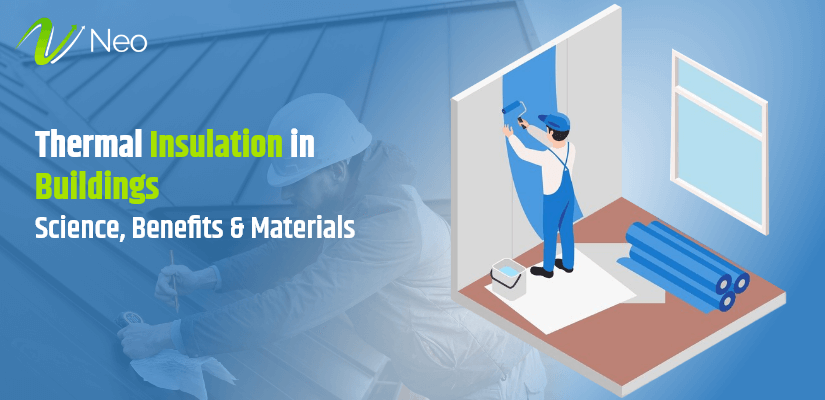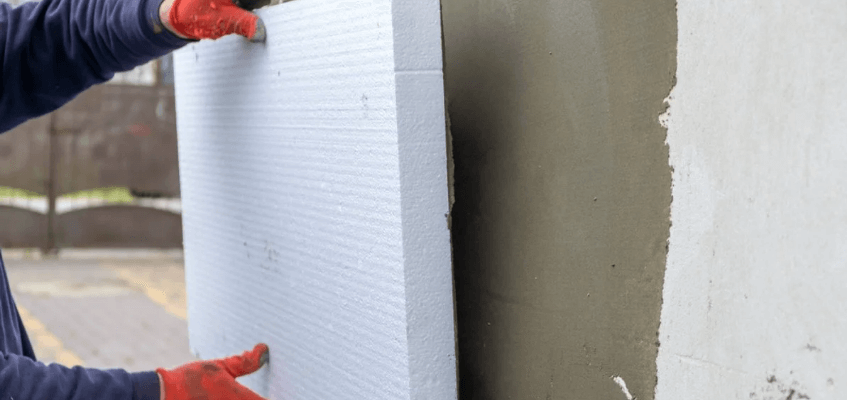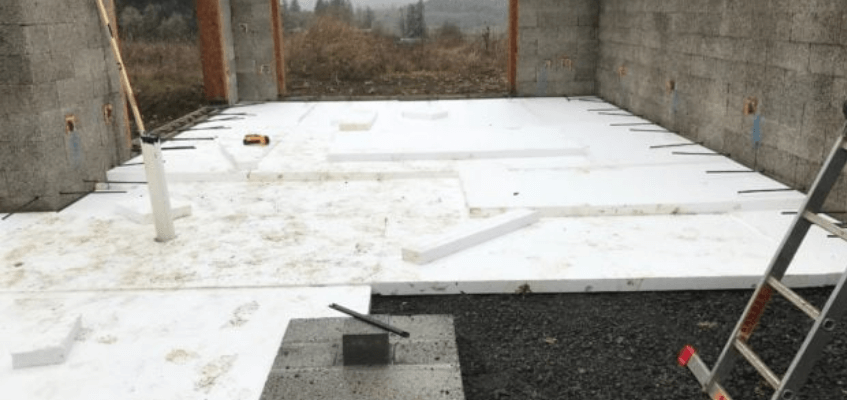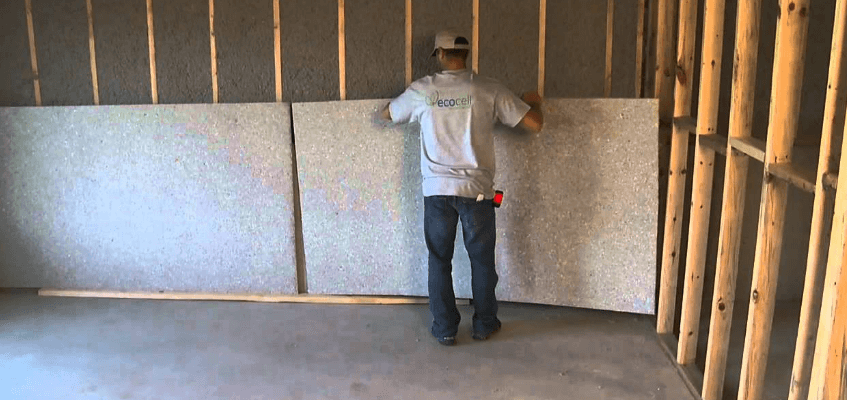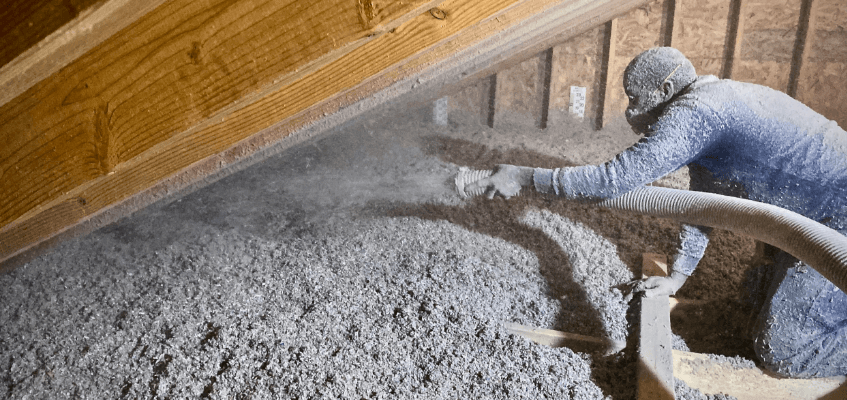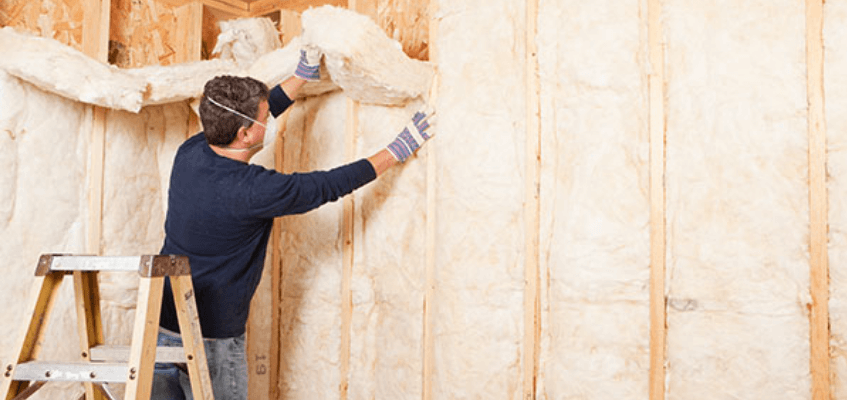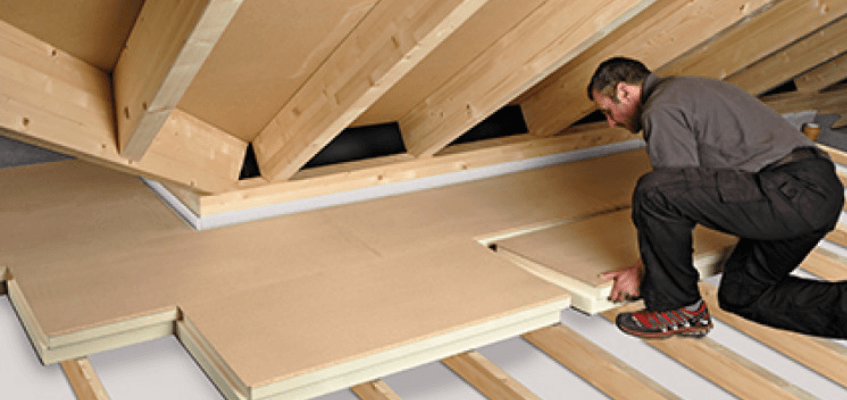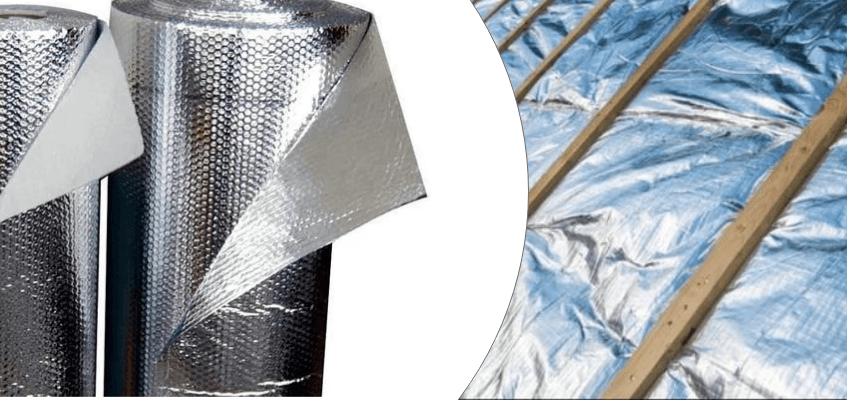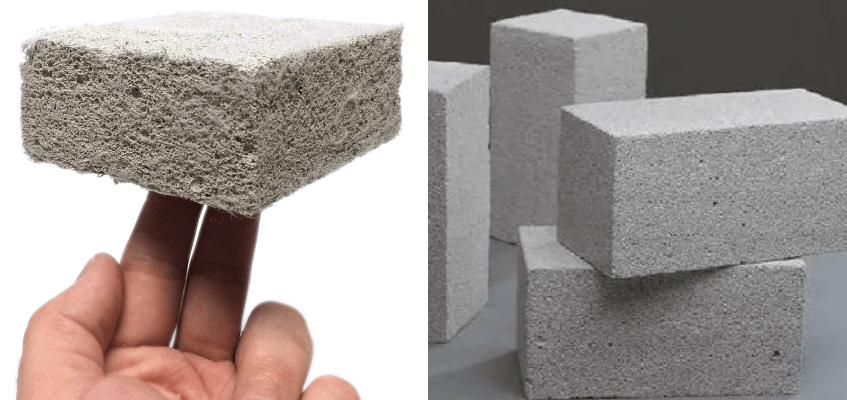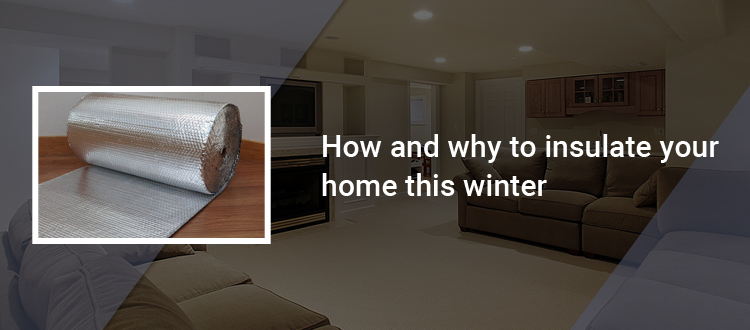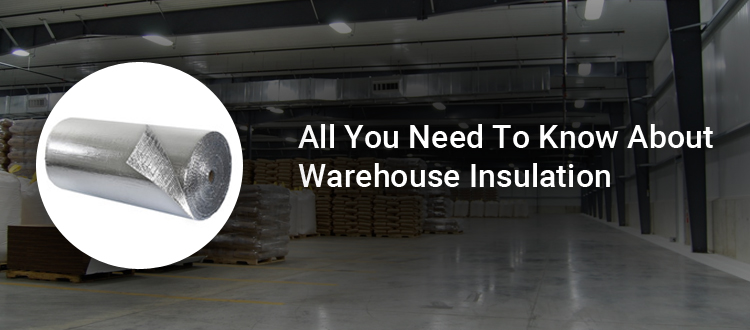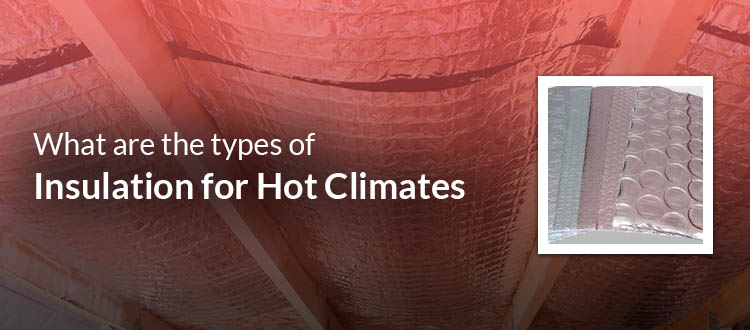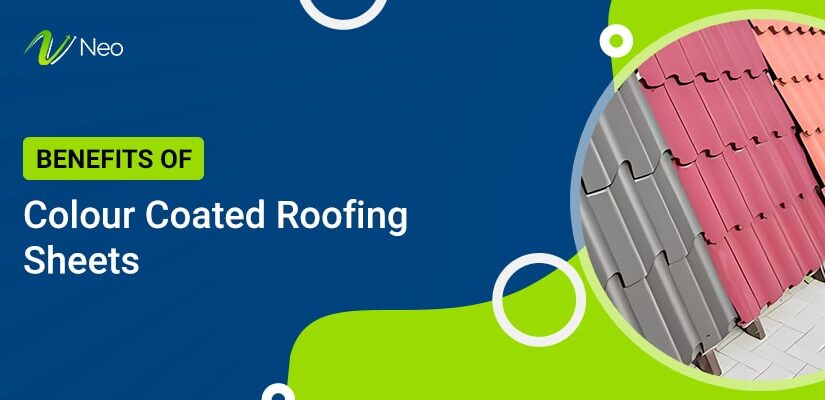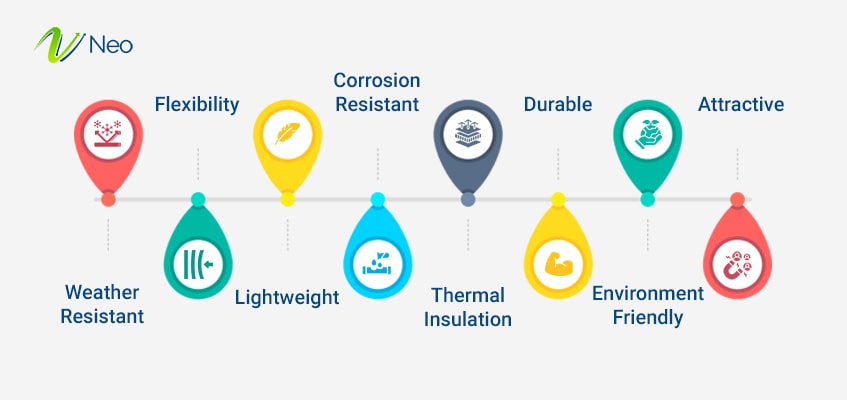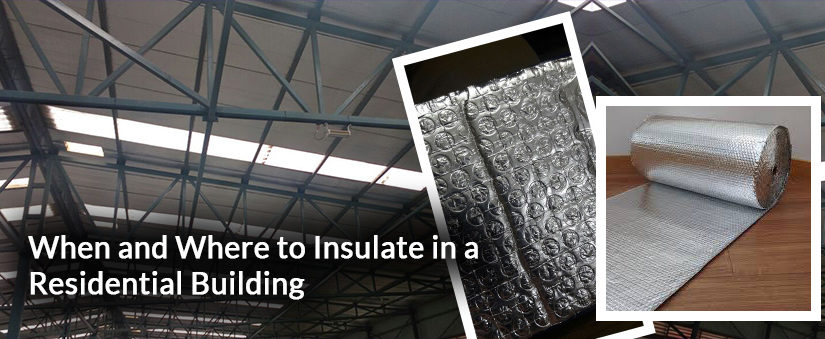Temperature differences throughout the year can be observed in most of the regions of India. For the same, people rely heavily on electrical appliances air conditioners, heaters, blowers, geysers, and many more which contribute significantly to the increased electricity bills. So, thermal insulation comes as a great solution that helps to maintain the temperature inside any building, commercial space, or residence, without the use of any heavy electrical appliance. As per the Research and Markets, the building thermal insulation market of India was valued at INR 2,189.8 crores which is all set to achieve the valuation of INR 3,674.9 crores by 2028. Let’s explore this flourishing market and talk about some benefits that you can leverage with the insulation concept.
What is Thermal Insulation?
Thermal insulation is the mechanism that reduces the heat transfer between solid substances, liquid surfaces, or gases by installing a barrier between them. As long as the heat is not being transferred from one object to another, the surroundings will not have any temperature impact. Be it any industry or place, thermal building insulation can be installed anywhere to ensure that the heat doesn’t travel from the house’s roof and walls to increase the inside temperature.
However, the same needs to have optimal thermal environments to perform efficiently.
How Does Thermal Insulation Work?
As we interpreted in the earlier section, thermal insulation acts as the obstacle between two surfaces so that the high temperature of the outside surface does not travel to the inside layer of the premises to maintain the optimal temperature. Similarly, if the heat is coming directly from the roof area, the roof insulation will not allow the heat to travel inside the room and thus maintain the lower temperature.
Material with the lowest thermal conductivity is used for the insulation that minimizes the heat transfer between the surfaces. However, it is not all about thermal conductivity but there is a range of other factors which are considered when selecting the best thermal insulation. The factors are but not limited to density, thickness, thermal resistance, thermal diffusivity, heat capacity, etc.
When talking about popular types of thermal insulation, include fiberglass, mineral wool, polystyrene, and polyurethane foam. Aerogel, pyrogel, and advanced vacuum insulation are some of the most preferred thermal insulators by most industries.
Benefits of Proper Thermal Insulation in Your Homes
Thermal insulation doesn’t only maintain the optimal temperature inside a residence but it has a lot of other advantages as well. Be it a sustainable option for healthy living or saving a lot of money by cutting into the electricity bill, thermal insulation benefits are huge. Let’s have a glance over some of the insulation advantages in residential places.
1. Energy Saving
The foremost benefit is undoubtedly the big energy saving as installing insulation between the walls will not allow the outside heat to enter the premises. It reduces the reliance on heavy electrical appliances which ultimately contributes to reducing electricity bills. However, there are certain considerations when choosing thermal building insulation for your house. For example, suppose you are buying a property that is already protected with thermal insulation. In that case, it is better to monitor the insulation to ensure that it doesn’t have any holes, gaps, ceiling cavities, or other similar issues.
2. Environment Friendly
Another major benefit of insulation is sustainability and environment friendly. Thermal insulation significantly reduces the dependence on natural gas and coal which reduces the emission of carbon dioxide, sulfur dioxide, and other harmful greenhouse gases. At the same time, the elimination of these chemicals is also safe for the ozone layer which contributes to overall environmental health. Less use of air conditioners and heaters also reduces the chances of global warming and climate change. At the same time, there are even eco-friendly thermal insulation that have no negative impact on the environment even in the manufacturing process.
3. Acoustic Benefits
Acoustic sheets are a type of thermal insulation that not only restricts high temperatures from entering the premises but at the same time, it also prevents sound from entering the space. Acoustic thermal sheets are much denser than the normal insulation sheets and thus it is more capable of restricting both heat and sound from entering the surface. Soundproofing insulation can easily be installed in the external and internal walls and mid-floor in multi-story dwellings. So, you can even create quiet zones in your house by installing acoustic insulation sheets.
Schedule Your Insulation Installation Today.
4. Fire Resistance
Fire resistance is one of the greatest benefits of installing insulation on a property. Thermal insulation like Rockwool are designed specifically to stop the flames from spreading and that stop the fire inside a particular space only. Moreover, another benefit of using this type of thermal insulation is that it doesn’t emit harmful smoke on burning which ensures that the people inside the house don’t inhale the toxic smoke. Rockwool insulation even has great heating resistance and acoustic properties.
5. Reduces Moisture Condensation
Thermal insulation sheets help maintain the optimum temperature by preventing heat loss and heat transfer inside a space. So, the optimal temperature maintained in residence keeps the surface above a dew point which eliminates the chances of moisture condensation. The air barriers and vape control wall wrap can also be chosen to reduce moisture condensation. Still, they can not be used to reduce the heat transfer and maintain optimal temperature.
6. Comfortable Temperature
You must remember that thermal insulation is not a substitute for AC or heaters. Rather, it is just the health-friendly concept that helps to maintain the comfortable temperature inside the space by reducing heat loss. The use of electrical appliances reduces after insulation which leads to an overall healthy lifestyle. Also, the temperature is maintained throughout the day without switching anything on or off.
7. Elevates Property Value
Having a property that has an inbuilt mechanism to beat the heat as well as prevent the extreme cold can be a great highlight that increases the value of the house automatically. It is rare in India and telling the buyer about the core competencies of thermal insulation can instantly increase their interest in buying the property. At the same time, the optimal temperature inside the house will shape the buyer’s decision by providing them with a chilling environment as soon as they enter the house.
8. Long-Lasting and Cost-Efficient
Another thermal insulation benefits is that these solutions are long-lasting. With very little maintenance and care, you can use the same insulation for decades. Also, the maintenance cost of thermal insulation is very low when compared to the benefits it delivers.
Transform your space with Thermal Insulation
Different Types of Thermal Insulation Materials
There are different types of thermal insulation that you can choose for your residence. The choice of insulation entirely depends on the personal preferences, overall purpose, and budget of the project. For example, you can only choose thermal insulation material after finalizing the area where you want to install the insulation. Similarly, the R-value you want to achieve with insulation is also a big determinant factor in choosing the right one. Here are the types of thermal insulation along with their respective core competencies.
1. Aerogel
Aerogels are basically ultralight materials derived from a gel where the liquid component of the material is replaced by the gas without affecting the overall gel structure. As a result, we get a solid with extremely low density and low thermal conductivity. This material can be made by using a variety of chemicals. This is one of the most used thermal insulation types for the walls and surfaces which can not heavy weights for a longer time duration. At the same time, this technique is also widely used for heat management in electronics.
2. Cellulose
Cellulose insulation is one of the oldest forms of home insulation which is being used by people around the world even today. Cellulose insulation is loose-fill insulation that can be used for new and existing homes to prevent heat from entering the premises. Being a fiber insulation, these are used in the existing walls, unfurnished attic floors, and new walls. However, Cellulose is considered one of the most cost-efficient forms of insulation as it is made up of recycled cardboard, paper, and other similar materials.
3. Fiberglass Insulation
Fiberglass insulation is mostly used in modern times because of the reasons of how it is made. This insulation material is made by effectively plashing the glass into insulation. However, the handling of this insulation is one of the most difficult tasks as professionals need to wear proper protective gear when installing it. Otherwise, it can cause serious damage to the lungs, heart, eyes, and skin. Fiberglass can reduce the heat transfer immediately. This is a non-flammable insulation where the R-values range between R-2.9 to R-3.8 per inch.
4. Mineral Wool
Mineral wool is not one type of thermal insulation. On the contrary, it might refer to a range of insulation materials like fiberglass manufactured from recycled glass, Rockwool made from basalt, and more. Similarly, it can also refer to slag wool which is made from the slag obtained from steel mills. This insulation can be purchased in the form of batts or loose materials. However, the mineral wools don’t have any additives to make them fire-resistant. On the other hand, they are non-combustible material which prevents the spread of fires up to 1400 degrees Fahrenheit.
5. Polyurethane Foam
Polyurethane Foam is an excellent form of insulation as it uses the non-chlorofluorocarbon gas as a blowing agent. This concept helps significantly to prevent any damage to the ozone layer. Also, Polyurethane Foam is comparatively very light, which weigh only two pounds per cubic foot. At the same time, they have an R-value of approximately R-6.3 per inch of thickness. It is easy to install in the corners and hidden areas as all it has to do is spray the foam which will get thicker as soon as it comes into contact with the air.
6. Polystyrene insulation
This is basically a waterproof thermoplastic foam that prevents sound and heat from traveling from one surface to another. Polystyrene insulation comes in two forms which include expanded (EPS) and extruded (XEPS). Both of them are entirely different from each other in terms of cost, rating, and performance. XEPS has an R-value of R-5.5 while EPS stands at R-4. However, one of the downsides of polystyrene insulation is that it is flammable and thus needs to be coated with fire-resistant chemicals like Hexabromocyclododecane.
7. Earthwool Insulation
Earthwool insulation is very different from those of general categories of insulation. It is manufactured using the ECOSE technology which is sustainable, renewable, and doesn’t contain any formaldehyde. At the same time, petrol-based chemicals are also not used in the manufacturing process. This insulation is mostly used for residential, commercial, and industrial purposes. This form of insulation is available in different product types like wall, ceiling, floor, and acoustic products. There are different benefits of earthwool insulation which include environment-friendly, availability of acoustic products, low irritant products, high thermal performance, non-combustible, and much more.
8. Spray foam insulation
As the name suggests, this is the types of insulation that is installed using a blowing machine. This insulation is typically more expensive than the other insulation options and requires a well-trained professional to install it. This insulation is considered the best option for sealing air leaks, preventing mold growth, and avoiding any chances of water leakage. So, the chances of damage to the insulation are very low in spray foam insulation. There are two types of spray foam insulation viz. Open-cell foams and closed-cell foams. There are a range of benefits for using spray foam insulation including reduced energy consumption, eliminating air draughts in homes, eco-friendly products, long life span, and much more.
How to Choose the Right Thermal Insulation Material For Your Needs?
In the above section, we interpreted the different types of thermal insulation materials that you can use in your residence, commercial, or industrial properties. However, the final decision of choosing the best thermal insulation depends entirely on different factors. So, here are some of the key considerations that you must ensure when choosing the right insulation materials for your home.
1. Thermal Resistance
The biggest purpose behind the use of thermal insulation is to prevent heat from entering the surface and keep the internal temperature comfortable. For the same, you must choose a insulation material that has good thermal resistance. To ensure that your insulation choice has good resistance to heat, you must analyze the R-value of the material. The higher the R-value, the better will be the thermal resistance.
2. Thermal Conductivity
Your thermal insulation material should have the lowest thermal conductivity to act as a good insulator. Touching a material and if it feels cold than the normal temperature, it means that the material has lower thermal conductivity. On the other hand, if the temperature of the material is increasing over touching, it means that the material has higher thermal conductivity and will not be a good choice for insulation.
3. Moisture Resistance
The insulation material must have good moisture resistance. It will make sure that the materials are not absorbing the water which can negatively affect the overall insulating properties of the material. For example, you can choose materials like XPS which carry high moisture resistance.
4. Fire resistance
Having fire-resistant insulation installed at your home can be one of the great things that you can choose. Fire-resistant insulating materials provide you an assurance that the flames don’t spread in case of any incident at the place. Good fire resistance thermal insulations like Rockwool stone wool boards can save your home, commercial space, or factory from big losses by automatically controlling the fire.
5. Density
It is generally observed that the materials with higher density are a good choice because they are water resistant, carry greater hardness, and thus exhibit better-insulating properties. So, if an insulating material with less density is being used, the chances are that the water will enter and damage the overall insulation. At the same time, the lower insulating properties will not be able to prevent heat enter and leaving the surface. So, the inside temperature will gradually increase.
6. Environmental impact
It is very important to ensure that we are not causing any negative impacts on the environment when installing insulation at our place. So, you can go for eco-friendly materials when choosing the thermal insulation. Mineral wool is one of the best and most preferred insulation that you can choose as an eco-friendly material choice.
7. Soundproofing
Moving ahead, if you want to make your space more comfortable so that the outside noise doesn’t disturb you, choosing a soundproof thermal insulation material can be a good idea. For example, the Rockwool insulation is one of the soundproof insulation that makes sure you have an overall good environment at your place.
Say goodbye to energy waste.cut the costs! Choose thermal insulation now.
Applications of Thermal Insulation in Various Industries
Thermal insulation is being used in a range of industries for its capability of maintaining the optimal temperature inside a space and preventing the outside environment affect the inside of a house. Let’s explore some of the industries that have the maximum usage of thermal building insulation for different purposes.
- Commercial and Residential Building – It takes a lot of energy and money to maintain the optimal temperature inside the buildings with the help of electrical appliances. At the same time, this system is a big cause behind global warming. So, thermal insulation is a great choice that keeps the building at a comfortable temperature without any energy requirements.
- Mechanical Insulation – Machines generate a large amount of heat when functioning for a long time. This heat can be transferred to other spaces via pipes or other mediums. So, pipe insulation is used to prevent heat transfer and control the overall temperature.
- Electronic Appliances – It is used in different electrical appliances to prevent the transfer of heat from one part to another. For example, there is a heat pump in refrigerators along with a thermally insulated chamber.
- Spacecrafts and Automobiles – Similar to those of mechanical applications, thermal insulation is used in spacecraft and automobiles as well. It helps to keep the heat trapped inside a surface only that doesn’t impact the temperature in other areas of machinery.
- Education – Schools, colleges, and universities are continuously adopting thermal insulation practices as they provide a better learning environment to the students. At the same time, the campuses of educational institutes are generally very big which makes it too costly to install electric systems for temperature maintenance. So, it is one of the tactics that keeps the premises cool.
- Healthcare – Thermal insulation is used widely in the healthcare industry buildings. First of all, it helps keep a comfortable temperature for the patients. Moving ahead, it improves the air quality by reducing the amount of air infiltrated into the buildings. Thus, thermal insulation is a great choice for patients’ health as well.
Techniques of Thermal Insulation
Different techniques are used for thermal insulation. The technique can only be chosen by monitoring the causes of heat transmission. Here are the different thermal insulation techniques used worldwide-
Roof Thermal Insulation
This is the thermal insulation for the roof which is installed when most of the heat is entering through the roof only. The insulation can be done from the inside as well as outside of the roof. The thermal insulation is often installed above the slab. The following are the techniques that can be used for roof thermal insulation-
- Heat-insulating material can be put over the roof under a waterproof course only.
- A false ceiling made up of insulation material can be installed on the interior ceiling.
- Reflective insulative materials can be positioned on the rooftop.
- Asbestos sheets can be used over the bricks to create air holes over rooftops.
- Misting the rooftop with water can stop heat flow.
Insulating Thermally Exposed Walls
- The thermal insulator can be created to some extent by increasing the thickness of the wall. However, this method is very expensive.
- Hollow walls act as an excellent thermal insulator.
- Heat-insulating materials can be used with other building materials while constructing the wall.
- Heat insulators can be installed on both sides of the wall to lessen the thermal transmittance.
- Batten sheathing or hardboard can be installed on each side of the partition in order to create air gaps.
Why Choose Neo For Thermal Insulation Installation?
Thermal insulation and related materials are a long-term investment as the insulation can not be performed every now and then. So, it becomes important that you choose a reliable and experienced professional for your project. There are chances of a lot of delay or over-budgeting that might affect the overall outcome of your project. Neo Thermal Insulation, on the other hand, is a well-known brand in the industry. We have served a huge client base coming from different niches and industries. Our consultation services ensure that the client chooses the right insulation material according to their particular requirements and budget.
At the same time, Neo Thermal makes sure that the installation is being done efficiently in the least time so that the client doesn’t have to face any kind of inconvenience. We complete the project within the defined budget so that the client doesn’t have to compromise with their monetary budget planning.
Conclusion
So, it can be concluded that effective thermal insulation is a great technique that enables people to maintain optimum temperature inside their space without relying heavily on electronic appliances. Also, there are different budget requirements and timelines of the project that the customer has to choose according to specific needs. Neo Thermal Insulation, in this industry, carries a prestigious presence that enables us to deliver high-quality services to our clients.
Frequently Asked Questions
1. Is thermal insulation installation a DIY project?
Answer- Installing the thermal insulation entirely depends on the type of insulation material. Insulation types like fiberglass or mineral walls can be installed by anyone with little care. On the other hand, spray foam insulation, requires a professional to work on the project.
2. Why is thermal insulation used in buildings?
Answer- There are multiple purposes for using insulation in buildings. It includes maintaining a comfortable temperature, soundproofing, preventing water leakage, reducing electricity bills, installing a sustainable and environment-friendly solution to the building, and much more.
3. What are some common types of thermal insulation?
Answer- Some common types of thermal insulation materials are but not limited to mineral wool, cellulose, fiberglass insulation, polystyrene, spray foam, ceramic fiber, etc.
4. Does thermal insulation reduce noise transmission?
Answer- There is acoustic insulation which is designed specially to prevent the sound from entering a particular space. This insulation ensures that neither the heat nor the sound moves from surface to surface.
5. Is thermal insulation environmentally friendly?
Answer- Yes, thermal insulations are completely environmentally friendly as they don’t cause carbon emissions, contribute a lot to energy saving, and reduce environmental pollution.
